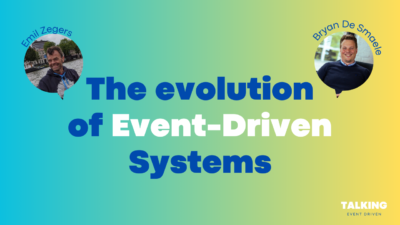Has ERP come to an end?
Enterprise Resource Planning (ERP) software has been a staple of business IT for many years, but could this be coming to an end? With the rise of cloud-based and modular enterprise solutions, ERP may find itself struggling to keep up with the times.
In this blog post, we will explore the potential future of ERP software and how Event-Driven Architecture (EDA) can help businesses make the most of their resources. Stay tuned – the future of ERP is looking cloudy!
The enterprise technology landscape is changing rapidly, and this is having a big impact on the way that businesses operate. One of the most notable changes is the rise of cloud-based solutions, which are often more modular and easier to integrate than their traditional counterparts. This shift has led many experts to question the future of ERP software, and whether it will be able to keep up with the changing demands of enterprise IT.
ERP vendors like Microsoft, Oracle, and SAP have certainly tried to keep up. Their products have evolved to SaaS-based offerings, expanded with additional functionalities. These functionalities typically come from specialised applications, bought by the vendors in hopes of offering a one-size-fits-all solution. But is it enough?
It’s important to note that more functionality also means more complexity. More often than not, these products weren’t built to run in the cloud from the start. This makes it harder for them to take advantage of the benefits that the cloud has to offer. They are more difficult to scale, and functionalities might not work in more complex environments like a multi-region setup that does not share its databases.
So, can one product really be a solution for a wide range of industries? Shouldn’t software help companies differentiate their core business and adapt to their changing business strategies instead? ERP code is difficult to customise by definition, and any customisations risk being compromised with each new version deployed by its vendors. Not only does this make maintenance difficult, but upgrading can become near impossible.
Organisations need to change to stay relevant, so the rigidity of ERP software can become a serious bottleneck in their ongoing digital transformations. We believe that this will lead to the end of ERP software as we know it. Instead of trying to accommodate all customers and use cases, there is a shift towards specialisation.
Applications like Salesforce, Copper, and ServiceNow cater to specific parts of organisations. Many IT executives are taking advantage of this evolution to mix and match applications into a best-of-breed solution. This means that integrating these solutions in a structured manner has become more important than ever.
Unfortunately, companies trying to keep their current architecture are faced with the fact that ERP solutions usually focus on assimilation rather than integration. They try to support as many business processes as possible. Organisations are forced to adapt their processes to the software, instead of the other way around. If they offer integration, it is often heavily biassed toward other offerings of the ERP vendor or its partners. This vendor lock-in prevents organisations from achieving that best-of-breed solution they are looking for.
Another way of looking at integration is structuring your architecture around business events, rather than what does or doesn’t fit in a software suite. These events represent the actions that underlie an organisation’s business processes and factor in the relevant data for any changes. They are not only crucial for applications, but also for overall business transparency, analysis, and reporting.
That’s where EDA comes in. In an Event-Driven Architecture, all applications send business events to an event hub that is fully structured and horizontally scalable without losing the order of events. Unlike a traditional Enterprise Service Bus (ESB), the event hub doesn’t have business logic, and it still lets applications consume the data in real time. It is up to the organisations, not their vendors, to define which application will be responsible for which business domain.

Traditional ERP systems can also produce and consume business events, but they will always have some limitations. The events will be harder to implement, less flexible compared to specific applications or microservices, and will never offer a single solution for all organisations as advertised.
In our opinion, these traditional ERP systems will start to fade out because of their rigidity, while best-of-breed solutions will offer growing and adapting organisations a much-needed alternative. When those solutions are combined with purpose-built applications and services in an Event-Driven Architecture, they will help organisations achieve the flexibility they need to stay ahead of their competition.
Not sure if EDA is the right fit? Wondering if there is a feasible alternative to your ERP-supported architecture? At Cymo, we’re at the forefront of implementing Event-Driven Architecture and developing enterprise-grade EDA functionalities. Contact us today to find out more!
Contact
Written byKris Van Vlaenderen
Read more

PODCAST (S1 - E8): the evolution of event-driven systems
In this episode, Emil Zegers shares his insights with Bryan on how he thinks building a design-first strategy and mapping that to your runtime deployment is the way to go when it comes to Event-Driven Systems. Do you agree?

PODCAST (S1 - E7): the journey of becoming an Event-Driven Organisation
In this episode, Kris Feys shares his insights with Wout on how he thinks EDA is the future, but comes with a lot of change... Change that not everyone is ready for. Are you?

PODCAST (S1 - E6): the role of AI in Event-Driven Architecture
In this episode, Dunith Danushka shares his insights with Bryan on how he thinks EDA has the ideal foundation to build on with many technologies (and trends). It's a must-watch for anyone wanting to optimize their event-driven journey!
